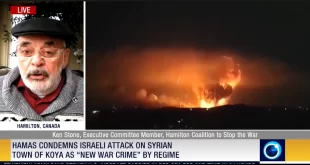Aug 24, 2014, Stephen Gowans
One of the roles of leading politicians and top officials of the state is to enlist public support for policies which serve the goals of the upper stratum of the population from whose ranks they sometimes come and whose interests they almost invariably promote. When these policies are at odds with the interests of the majority, as they often are, the mobilization of public consent is possible only through deception. The deception is carried out through prevarication, equivocation, and fear-mongering, crystallized into misleading narratives which the mass media can be reliably counted on to amplify. So it is that Western officials have ramped up a campaign of deception to provide a pretext for military intervention in Syria to combat ISIS but which may very well serve as a Trojan horse to escalate the war on the Syrian government.
The foundations of the campaign were laid in March, when US officials began warning that Islamists bent on launching strikes against Europe and the United States were massing in Syria. [1] The campaign kicked into high gear with ISIS’s territorial gains in Iraq and the organization’s beheading of US journalist James Foley. Now US officials say they are contemplating air strikes against ISIS targets in Syria.
To justify the possibility of an air-war in Syria, US officials employ nebulous language about safeguarding US “security interests,” but neglect to spell out what those interests are or how they’re threatened. US defense secretary Chuck Hagel calls ISIS an “imminent threat to every interest we have,” adding that ISIS “is beyond anything that we’ve seen.” [2] Hagel doesn’t say how ISIS is a threat to even one US interest, let alone all of them, while his elevation of ISIS to a threat “beyond anything that we’ve seen” is transparent fear-mongering. Clearly, ISIS’s brutality in Iraq, its beheading of Foley, and its ability to seize and control territory, have been no more shocking than what has transpired in Syria, where ISIS and its fellow Islamists have carried out equally bloody displays of depraved cruelty, while seizing and controlling sizeable swaths of Syrian territory, amply assisted by members of the US-led Friends of Syria.
Hagel also invokes 9/11, suggesting that ISIS “is more of a threat than al Qaeda was before the Sept. 11, 2001 attacks.” [3] Invoking 9/11 invites the conclusion that without airstrikes on Syria to eliminate ISIS, that an attack on the United States on an order greater than 9/11 is a serious possibility, if not inevitable. France’s foreign minister, Laurent Fabius, also points to 9/11 to buttress the case for airstrikes, noting that “The attacks in New York on Sept. 11, 2001, cost $1 million. Today, we estimate the Islamic State has several billions.” The obvious conclusion Fabius wants us to draw is that ISIS will launch thousands of 9/11s. [4] The implied conclusion, however, is no more credible than the implied conclusion that the United States is on the brink of vaporizing the planet because it now has a nuclear arsenal that is vastly greater than the tiny one it had when it atom-bombed Hiroshima and Nagasaki. Capability does not necessarily equate to motivation or action. What’s more, the “FBI and Homeland Security Department say there are no specific or credible terror threats to the U.S. homeland from the Islamic State militant group.” [5]
General Martin E. Dempsey, chairman of the US Joint Chiefs of Staff, offered his own contribution to the emerging campaign of fear-mongering. Dempsey observed that ISIS aspires to absorb “Israel, Jordan, Kuwait and Syria into its caliphate.” [6] This is manifestly beyond ISIS’s capabilities, and merits no serious discussion. Dempsey nevertheless adds that if ISIS “were to achieve that vision, it would fundamentally alter the face of the Middle East and create a security environment that would certainly threaten us in many ways.” [7] This is tantamount to saying “If Haiti had an arsenal of 200 thermonuclear weapons and an effective anti-ballistic missile defense system it would certainly threaten us in many ways.” What’s important here is the word “if.” If Barack Obama was a woman he would be the first female US president. If ISIS has the capability of absorbing a large part of the Middle East into a caliphate, it would be a threat to US control of the Middle East. But ISIS does not have this capability. Still, even if it did, it would not be a threat to US security, but to the security of Western oil industry profits.
For its part, The Wall Street Journal suggested that James Foley’s beheading was reason enough to warrant US airstrikes on Syria. [8] Yet beheadings, carried out by ISIS and other Islamists in Syria, and those carried out by US-ally Saudi Arabia against its own citizens, have hardly galvanized Washington to action. Washington’s Saudi ally “beheaded at least 19 convicted criminals since Aug. 4, nearly half of them for nonviolent offenses, including one for sorcery.” [9] These beheadings have been passed over by Western leaders in silence. They certainly haven’t been invoked as a reason to launch air strikes on the Saudi tyranny.
Also passed over in silence by the same Western states is the brutal, misogynist, medieval character of the anti-democratic Saudi regime, one of the principal “Friends of Syria.” In contrast, The New York Times reported that “The president and his top cabinet officials have all denounced the Islamic State as a medieval menace,” adding that US “Secretary of State John Kerry said the group should be destroyed.” [10] What the newspaper didn’t point out was that Saudi Arabia is just as much a “medieval menace” yet no US president or secretary of state would ever use this language to describe their ally, nor, more importantly, undertake a campaign to eliminate the medieval regime. This underscores the reality that Washington bears no animus toward medieval menaces—not when, as in the case of Syria, they operate against the government of a country targeted for regime change, not when they govern a source of immense petrochemical profits on terms favourable to Western oil companies, and not when, as in Afghanistan in the 1980s, they fight against a progressive, pro-Soviet government.
Washington’s campaign to mobilize public opinion for air strikes on Syria, then, has nothing whatever to do with eradicating medieval menaces. Nor has it anything to do with preventing the rise of a caliphate in the greater part of the Middle East, since ISIS hasn’t the capability to accomplish this aim. Even if it did, the rise of a caliphate is a matter for the people of the Middle East to decide, not Western powers. Lastly, until ISIS achieved startling territorial gains in Iraq, Washington was perfectly willing to allow, indeed, even to foster (what it now calls) “the cancer” of ISIS to “metastasize” throughout Syria. It expressed no apprehensions then about ISIS launching 9/11-style attacks on the United States, and did nothing to stop the flow of money to the anti-Assad group from supporters based in countries that make up its Friends of Syria (read Friends of US Imperialism) coalition. Warnings of an ISIS-engineered 9/11-style attack are, therefore, pure fear-mongering.
In light of the above, we ought to ask whether, once launched, a US air-war in Syria will expand its target list from ISIS to Syrian government forces? Is the campaign to mobilize public support for an air war against ISIS in Syria a Trojan horse to escalate the war on the Assad government, and on a broader level, against the interlocked Hezbollah-Syria-Iran resistance against US domination of Western Asia?
1. Eric Schmitt, “Qaeda militants seek Syria base, U.S. official say”, The New York Times, March 25, 2014.
2. Mark Mazzetti and Helene Cooper, “U.S. isn’t sure just how much to fear ISIS,” The New York Times, August 22, 2014.
3. Dion Nissenbaum, “U.S. considers attacks on ISIS in Syria”, The Wall Street Journal, August 22, 2014.
4. David Dauthier-Villars, “France calls for action to cut off ISIS money supply”, The Wall Street Journal, August 22, 2014.
5. Eileen Sullivan, “FBI: No credible threats to US from Islamic State,” The Associated Press, August 22, 2014.
6. Mazzetti and Cooper.
7. Mazzetti and Cooper.
8. Nissenbaum.
9. Rick Gladstone, “Saudi Arabia: Executions draw rebukes”, The New York Times, August 21, 2014.
10. Nissenbaum.
 Syria Support Movement solidarity with the Syrian people
Syria Support Movement solidarity with the Syrian people




